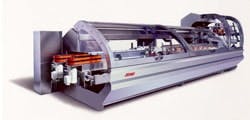An Allen-Bradley MP-Series servo. Courtesy of Rockwell Automation.
|
Servo advantagesBusiness pressures aside, servo-based equipment offers advantages over shaft-driven equipment, says Mike Wagner, business development manager at Rockwell Automation (Milwaukee). "Before servos, packaging machines had one large AC motor running at a fixed speed," he says. "Mechanical linkages off the main shaft would control each packaging process, translating shaft motion from one speed to another or from rotational to linear motion."For each revolution of the main shaft, you had one product coming out the other end, Wagner continues. Every time you wanted to go from vials to bottles or change the size or shape of the package, you had to reconstruct the machine."Servos change the game. Instead of mechanical linkages to a main shaft, each servo (which includes motor, gear head, and software) operates independently."Everything can be modified pressure, velocity, position," says Wagner. "Before, it would take seven hours to make those changes, so you didn't want to do it unless you had a large enough lot to run effectively. Now you can make the changeover in three to five minutes. It's like loading a recipe."Freeing servos from the drive shaft enables them to adjust independently to each event during the packaging process. "Imagine a simple low- to moderate-speed bottling line," posits Bob Hartwig, vice president of Pester USA, a subsidiary of the German packaging equipment firm. "It's made up of a host of simple machines, all of them interdependent and working in concert. As the system collects data, the servos on the line can adjust independently to any production problem as it occurs."Servos also offer an entirely new level of speed and precision, adds John Kowal, global marketing manager for Germany's ELAU, Inc., Europe's leading manufacturer of servos for packaging. Kowal estimates that 70 to 80% of the stretch banders, overwrappers, case packers and palletizers now sold to pharmceutical companies use servos."One of the great things about servos is their closed-loop feedback, he says. Our servo-based capper controls torque to +/- 0.02% versus 20% for a standard clutch-drive capper. We know exactly what values are. We can actually store the torque value for each cap, so if there's a recall, we may only have to recall 1,000 bottles instead of one million bottles." The same data can also be analyzed for trends that indicate wear or a need for maintenance.Since servos use much smaller motors, maintenance is rare. "Servos have a mean time between failure (MTBF) of 200,000 hours," Wagner says.21st century manufacturingFinally, servos are far more affordable than in the past. "Five years ago, servos cost about $10,000 a pop," says Hartwig. "Nowadays, they cost about $5,000 each and prices are still falling." On an inexpensive machine that costs $100,000, adding 10 servos would increase the price by 50%.Add those same 10 servos to a larger unit costing $500,000 to $1 million and the cost is hardly noticeable. The payoff, however, is huge: a large, fast line that is flexible enough to package solids and liquids in a variety of containers in short and long production runs."They're faster, more accurate, easier to control, easier to maintain, easier to implement, and longer lasting," says a project manager at a leading pharmaceutical manufacturer who did not want to be identified. He says his company is installing all-servo packaging lines when old systems wear out and when it builds new plants. "We're in the 21st century, and this is a new way to run plant. Servos help us predict problems before they occur. They tell us where to troubleshoot. Everything about them is easier. They are a step above driveshaft machines," he says.Blue screen of deathThat's the good news. And if it were the only news, then every pharmaceutical company would be using servos. That is not yet the case, and the reason has to do with servo system controls.To appreciate why servos can make the hair stand up on the back of a manufacturing engineer's neck, look first at the old-fashioned drive-shaft packaging lines. They may not be flexible or precise, but their mechanical linkages make them very, very predictable. A PLC using ladder logic engages one function after another. It is a system that is relatively easy to validate.Servos, on the other hand, are independently operated modules that depend on software rather than gears, chains, and cams to execute their operations. Many of them use PC-based processors. This is both a strength and a weakness. On one hand, PCs make drag-and-drop and touch-screen control possible. They support sophisticated data gathering, transmission, and analysis, as well as integration of 21 CFR Part 11 compliant audit trails.Unfortunately, those strengths are also PCs' weakness. "PCs are not like a PLC's ladder logic," explains R.A. Jones & Co. Inc. sales director Rusty Sparling. "PCs can do 10 different things at the same time, so it's a challenge to validate a machine when all those functions are going on simultaneously."A pharmaceutical machine has to operate the same way every single time. Instead of three paths, there can be only one path to an outcome and it always has to be the same path," Sparling says. "The concern with a PC system is that if one thing goes wrong, the PC will find another path around it."Darren Elliott, R.A. Jones' chief electrical engineer, is even more succinct: "They've seen the blue screen of death on their desktop computer," he says, referring to a frozen PC, "and they're afraid of that occurring in their repeatable process."





